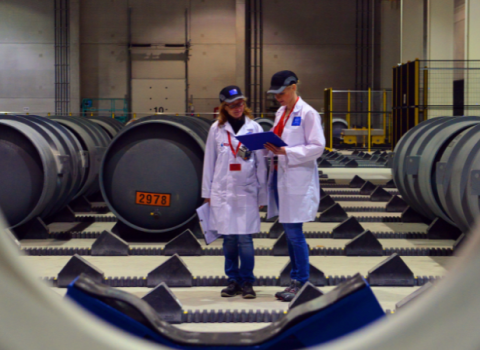Funding opportunity
The UK Carbon Trust has launched a global competition to find solutions to the problem of transferring engineers and equipment safely from boats to wind turbines as far as 300 kilometres offshore in waves up to three metres high. The project aims to improve the economics of offshore wind.
The need for better means of access is driven by the location of wind farms to be built over the decade. Existing wind farms are typically less than 20 kilometres from shore in relatively benign sea conditions. Turbines are typically available to generate electricity for 90 per cent of the time. They require planned and unplanned maintenance during the year, and this is performed by personnel who have to step off boats onto ladders on the side of the turbines. While this works effectively and safely in calm seas, conditions in future wind farms may be so rough that transfers may only be possible 160 days a year.
If safer, more reliable transfers were possible, it would increase the window for performing maintenance activities, which would increase the operating hours of the turbines and improve the overall economics of the wind farm.
The competition aims to generate at least a 4 per cent increase in turbine availability through the development of new technologies for the most challenging sea conditions. The global market opportunity for these access technologies is estimated to be worth over £2 billion by 2020. According to Carbon Trust research, the UK market would account for up to fifty per cent of that.
The competition is part of the Carbon Trust’s Offshore Wind Accelerator, a collaboration with eight energy companies, DONG Energy, E.ON, Mainstream Renewable Power, RWE Innogy, Scottish Power Renewables, SSE Renewables, Statkraft and Statoil, which aims to drive down the costs of energy from offshore wind by 10 per cent.
Technologies of interest are:
Transfer systems – To transfer personnel and equipment from vessel to turbine, potentially with motion-compensation;
Vessels – Vessels for transporting personnel and equipment from permanent bases or mother-vessels to turbines, incorporating a transfer system;
Launch and recovery systems – Systems fitted to the permanent bases or mother-vessels for launching and recovering daughter-vessels from the sea.
Successful applicants to the competition get funding of up to £100,000 per concept to support the design and development of the successful concepts; the opportunity to work with eight offshore wind developers with licences to develop 30GW of offshore wind capacity in UK waters (representing 60 per cent of today’s licensed UK capacity) and potentially several million pounds of funding to take the concepts to full-scale demonstration.
The competition is supported by RenewableUK, IMarEST (Institute of Marine Engineering, Science and Technology), RINA (Royal Institute of Naval Architects), SMI (Society of Maritime Industries), EWEA (European Wind Energy Association).
Companies interested can submit their designs until 5pm, 26th November by visiting http://www.carbontrust.co.uk/access or emailing [email protected].





 A unique international forum for public research organisations and companies to connect their external engagement with strategic interests around their R&D system.
A unique international forum for public research organisations and companies to connect their external engagement with strategic interests around their R&D system.